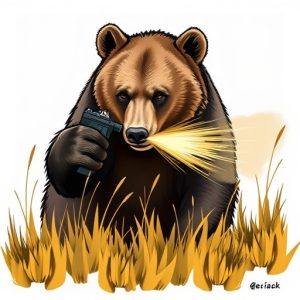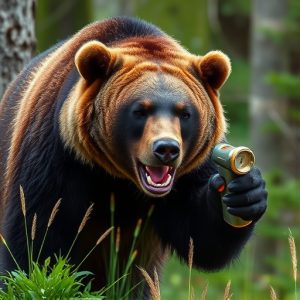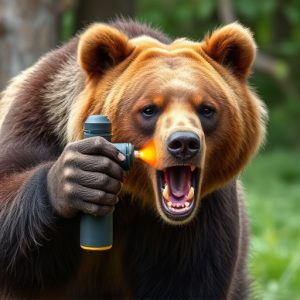Mastering Black Bear Defense: Optimal Distance & Spray Techniques
Understanding black bear behavior is crucial for determining the optimal distance of 20-30 feet (6-9…….
Understanding black bear behavior is crucial for determining the optimal distance of 20-30 feet (6-9 meters) for deploying bear spray, a safe and effective deterrent. Bears, though generally shy, can become aggressive when protecting their cubs or feeling threatened. Carrying bear spray offers extra protection during unpredictable encounters. The type of spray, weather, terrain, and bear behavior impact the effective range, requiring informed decisions by hikers and outdoor enthusiasts. Optimal application techniques involve aiming directly at the bear's face from a safe distance, with regular practice and checking expiration dates recommended. Following local laws regarding bear spray usage is essential, with proficiency developed through controlled practice, considering wind direction and terrain for maximum effectiveness.
“Navigating the wilderness or simply enjoying outdoor activities in bear country? Understanding black bear behavior and armed with the right tools, you can significantly reduce risks. This article delves into essential aspects of self-defense against black bears, focusing on bear spray as a game-changer. We explore when and where encounters may occur, demystify the science behind its effectiveness, and uncover the optimal distance for bear spray use. Learn about application techniques, legal considerations, and safety tips to ensure a secure outdoor experience.”
- Understanding Black Bear Behavior: When and Where to Expect Encounters
- What is Bear Spray and How Does it Work?
- The Science Behind Optimal Distance: Factors Influencing Efficacy
- Application Techniques: Maximizing the Effectiveness of Your Spray
- Legal Considerations and Safety Tips for Carrying Bear Spray
Understanding Black Bear Behavior: When and Where to Expect Encounters
Understanding black bear behavior is crucial when determining how and when to use bear spray as a defense mechanism. These bears are generally shy and reclusive, preferring to avoid human contact. They typically become aggressive only when they feel threatened or surprised, or if they are protecting their young. Black bears have an excellent sense of smell and hearing, making them aware of their surroundings even in dense forests. They are also curious creatures, often drawn to food sources or items that emit strong odors.
Encounters with black bears are most common in areas where humans and bears share the same habitats, such as forests, mountains, and wilderness zones. While they can be found year-round, peak seasons for bear activity vary by location. In North America, spring and early summer are typically when cubs are born, leading to increased bear movements and potential encounters with humans. The optimal distance to maintain from a black bear is at least 100 yards (91 meters), but carrying bear spray can provide extra protection if an encounter becomes unpredictable or aggressive. Staying calm, making yourself appear larger by raising your arms, and using bear spray when needed can significantly improve safety during such situations.
What is Bear Spray and How Does it Work?
Bear spray, also known as bear repellent, is a specialized pepper spray designed to deter and disperse aggressive black bears. Unlike traditional pepper spray used for self-defense against humans, bear spray is formulated to be extra potent and long-lasting, capable of reaching and affecting a bear’s eyes, nose, and lungs from a considerable distance.
When deployed at the optimal distance, typically between 20 to 30 feet (6 to 9 meters), bear spray creates a cloud that can effectively deter a bear. The main active ingredient in bear spray is capsaicin, the same compound that gives chili peppers their heat. This irritates the bear’s sensitive nasal and respiratory systems, causing it to back away rapidly. Ensuring you use bear spray from the recommended distance enhances its effectiveness while minimizing the risk of direct contact with the spray, which could potentially aggravate the situation.
The Science Behind Optimal Distance: Factors Influencing Efficacy
The optimal distance for bear spray effectiveness is a topic of interest and study in wildlife management and safety. Research indicates that the range at which bear spray is most effective can vary significantly based on several factors. One key variable is the type of bear spray used; different formulations and active ingredients have varying ranges and strengths. For instance, pepper-based sprays may have a shorter reach but are potent close up, while liquid aerosols can travel further but might be less concentrated at longer distances.
Other influences include weather conditions, terrain, and even the behavior of the bear itself. On a windy day, for example, spray particles can disperse more quickly, reducing the effective range. Rough terrain or dense vegetation can also disrupt the spray’s path, making it less precise. Additionally, the distance at which a bear is perceived as a threat can change based on the season and availability of food; bears may be less deterred during mating seasons or when they are raising cubs. Understanding these factors is crucial for hikers and outdoor enthusiasts to make informed decisions about carrying bear spray and maintaining safe distances from these powerful animals.
Application Techniques: Maximizing the Effectiveness of Your Spray
When using bear spray, understanding and practicing optimal application techniques is key to maximizing its effectiveness. For best results, aim directly at the bear’s face, eyes, and nose from a safe distance—ideally between 20 to 30 feet (6 to 9 meters). This range allows you to cover the animal’s sensitive areas while keeping yourself out of harm’s way. Hold the can upright, ensuring a steady stream as you spray. A wide fan pattern is more effective than a single, concentrated jet, allowing the spray to envelop the bear and minimize the risk of overspray on your surroundings.
Remember, the goal is not to hit the bear with precision but to create a barrier of pepper spray that disorientates it. Practice these application techniques in controlled settings before venturing into bear country. Regularly checking the expiration date of your spray is also essential, as outdated cans may not provide the same level of protection.
Legal Considerations and Safety Tips for Carrying Bear Spray
When carrying bear spray, understanding legal considerations is paramount. Different regions have varying regulations regarding the use and possession of pepper spray, especially in areas where black bears are prevalent. Always check local laws to ensure compliance; some locations may mandate specific types or brands, set minimum concentrations, or restrict carry permissions. Failure to adhere to these rules can result in fines or other penalties.
Safety is paramount when considering bear spray as a defense. Users should familiarize themselves with the product’s functionality and limitations. The optimal distance for deploying bear spray is typically between 20 and 30 feet (6-9 meters), but this can vary depending on the sprayer and environmental conditions. Practice using the spray in controlled settings to develop proficiency, ensuring you understand the wind direction and terrain to maximize effectiveness and minimize risk. Never aim or throw bear spray at a bear unless absolutely necessary, as it may ricochet or blow back, causing potential harm to you or others nearby.
When venturing into bear country, understanding black bear behavior and knowing the optimal distance for bear spray application can significantly enhance your safety. By recognizing when and where encounters are most likely to occur, along with the science behind the effective range of bear spray, you can make informed decisions. Mastering proper application techniques ensures your spray is used effectively during a potential encounter. Additionally, being aware of legal considerations and following safety tips for carrying bear spray is paramount. Armed with this knowledge, you’re better prepared to navigate these encounters confidently and safely in the great outdoors.


